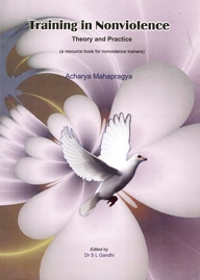Some two or three decades ago a thought arose in my mind. Acharya Tulsi was with me. In his presence I was discussing a particular subject: we always proclaim that ‘nonviolence is the highest dharma.’ I feel that this ghosh (slogan) should be number two. Number one should be ‘non-possessiveness is the highest dharma.’ The consciousness of nonviolence cannot be born unless the consciousness of non-possessiveness is first born. It can be rephrased thus: until the consciousness of anekant (non-absolutism) is awakened, the consciousness of nonviolence cannot be aroused. You must have seen the picture of Laxmiji. Two elephants flank her one on each side. Likewise, nonviolence is in the middle. On one side is nonpossessiveness, and on the other non-absolutism.
Clothing for 330 millions
Do not look only at Mahatma Gandhi’s thoughts, but also at his life. He was a fakir (mendicant) who had never been initiated into sannyas (asceticism) and yet his life was no less than that of a sannyasi. Today even sannyasis are fully dressed, but Gandhi wore only a loin cloth. In his entire life he wore just one piece of cloth. The same cloth was worn and also used as a blanket. A child once said to him, “Bapu! Do you have no clothes? I’ll have two sets of dress made for you by my mother.” Gandhiji very lovingly said, “Two sets of dress will not do for me. If you get 330 million sets of dresses made, I’ll accept them.” (At that time the population of India was 330 million).
He went to Britain to participate in the Round Table Conference wearing the same one-piece of cloth dress like a fakir. There the British journalists asked him, “Mr. Gandhi, are you and your country so poor that you do not have a proper dress to cover your entire body?”
Pointing at the British monarch, who was attired in a big imperial robe, he said, “What can be done? Your king is wearing as much as would be sufficient for ten men. According to our population and poverty, my share is just what I have on my body.” The seed of nonviolence can sprout only in the individual who has a feeling of non-possessiveness and is worried about others. It is the bond between ‘mine’ and possessiveness, which is becoming a problem. The feeling of nonviolence automatically arises where feelings of compassion, non-attachment towards material objects and non-acquisitiveness are awakened. People say that at the time of the freedom movement the whole country rose to support Gandhiji but I do not agree with that. People have strong feelings when it comes to gaining independence and having a strong urge for freedom. They automatically start backing a leader. This is not true for India alone. People rose to support Mao tse-Tung in China, Ho Chi Minh in Vietnam and Nelson Mandela in South Africa. The people of India were not behind Mahatma Gandhi but they were behind his charismatic personality, his devotion to duty and self-confidence. Alas! The character of India would have been very different, if only Indians could touch the soul of Gandhi!
 Acharya Mahaprajna
Acharya Mahaprajna

